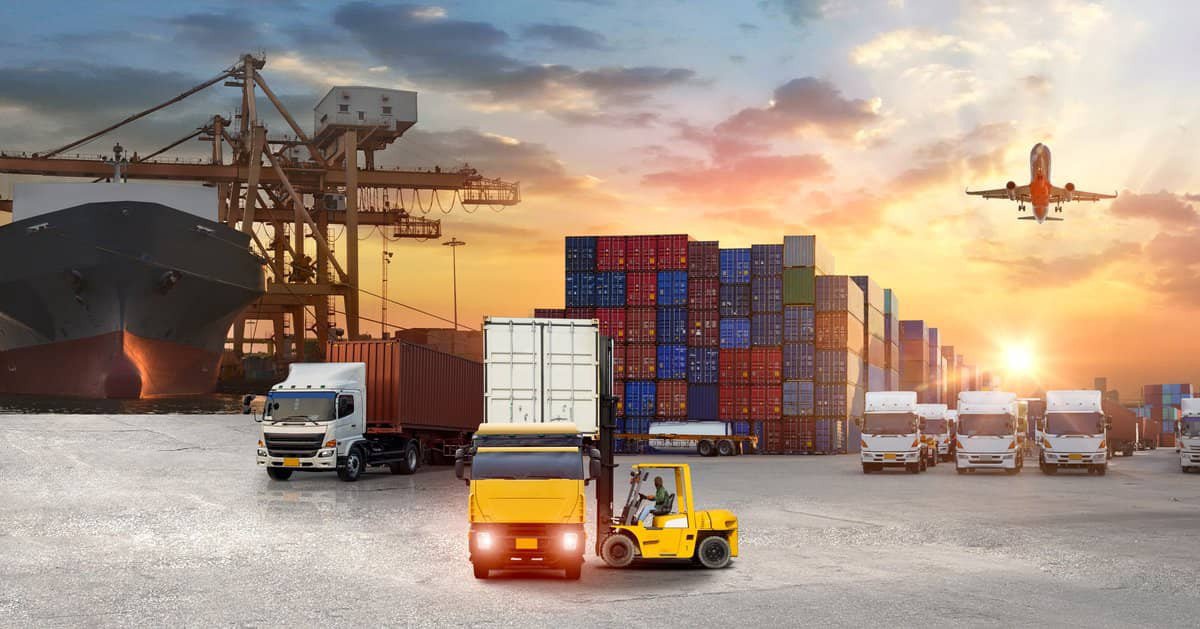
International shipping is complicated and can be intimidating for new importers - but it doesn’t have to be! This guide breaks it down to help you choose the right shipping option, understand pricing and sneaky surcharges, and navigate customs clearance. Finally, we discuss how digital freight marketplaces are simplifying the international shipping game with advanced technology solutions.
Demand for Imports and International Shipping
International shipping has been on the rise for decades, as advances in communication, technology and transportation provided an opportunity for a more global, interconnected supply chain. Companies found cost-savings by sourcing materials and labor overseas, and began shipping raw materials and finished products across the globe en masse. This model ultimately created a flourishing market for low-cost consumer goods and products around the world.
The COVID-19 pandemic unexpectedly drove increased demand for consumer goods, particularly in the U.S. Economic stimulus payments led to immediate spending, but in patterns that were vastly different from pre-pandemic. Unable to spend money on services like restaurants, travel, and salons, Americans were shopping online for goods and products. Consequently, direct-to-consumer and e-commerce sales soared, outpacing 2019 numbers by 32%. Many of those goods are manufactured overseas, so imports have been steadily rising for the last two years. Economic re-openings and easing of COVID restrictions seem to have done very little to slow import demand, so international shipping demand is likely to remain high.
What is International Freight Shipping?
There are two modes of transportation for shipping overseas – ocean or air. Which mode is best for your freight depends on several factors: urgency, cost, and shipment characteristics.
Air Freight
Air cargo is often used by global shippers when they need to get a shipment somewhere quickly and reliably. Speed is the distinct benefit of shipping by air instead of ocean – air freight arrives in days, while ocean freight takes weeks. Of course, the convenience and speed of air freight comes with additional costs, shipping by air is almost always more expensive than shipping by ocean.
Air freight rates are determined by the cargo weight and volume. It is important to note that carriers use several weight calculations when pricing air freight:
- Actual weight: gross weight of the cargo that is provided in an initial quote request.
- Volumetric or dimensional weight: estimated weight value based on cargo dimensions and cubic metric volume, multiplied by the air cubic conversion factor of 167. The formula for this calculation is: Volume (LxHxW) * 167Note: volume must be calculated in meters and kilograms
- Chargeable weight: weight that carriers use to quote air freight – the greater of actual weight vs. volumetric weight.
Chargeable weight may seem confusing, but it is designed to create a more equitable pricing structure by taking into account the lightness or heaviness of cargo (actual weight) and the amount of physical space the cargo takes up (volumetric weight). If pricing was based strictly on weight, shipping a pallet of steel bars might cost more than shipping three pallets of cotton. Accounting for volume evens the playing field for heavy and light cargo shippers.
Ocean Container Shipping
International shipping by sea accounts for approximately 90% of international freight, due in large part to its relatively low costs. Despite rising freight rates over the last few years, ocean freight remains the most popular method for shipping cargo internationally.
There are two options for ocean freight, based on the cargo and amount of space needed: full container load (FCL) and less-than-container load (LCL). Let’s look at the specifics for each option and explain when to use one over the other.
Full Container Load (FCL)
As the name implies, FCL shipping allows you to utilize a full, dedicated container to move your goods. This option is typically used when shipping larger volumes of cargo, or bulky non-standardized freight like machinery.
There are many equipment options for FCL ocean shipment, but three standard container sizes are most commonly used – 20’ general purpose, 40’ general purpose, and 40’ high-cube. Cargo volume determines which container is best-suited for a shipment - the chart below shows approximate capacity for each container option.
|
20’ / 20GP |
40’ / 40GP | 40HC | |
| Cubic Capacity |
1,156 CBF 32.7 CBM |
2,367 CBF 67 CBM |
2,619 CBF 74 CBM |
| Base Pallet Capacity |
10 Standard 11 Euro |
20 Standard 23-24 Euro |
21 Standard 25 Euro |
Weight is also important when selecting a container, but note that a container’s payload capacity is much greater than legal limits for road transport. A container may have a 55,000 lb (24,900 kg) payload capacity, but legal weight limits for hauling that container in the U.S. would limit the capacity to approximately 44,500 lb. Overloading an ocean freight import container can cause issues upon arrival and lead to additional charges for transloading or securing overweight permits for transportation.
Less-than-Container Load (LCL)
LCL shipping means your cargo is shipped in a shared container with other goods that are moving in a similar trade lane. This option is used for smaller shipments (less than 6 pallets or 13 CBM) and rates work similar to air freight based on cubic volume and weight. LCL is generally less expensive than securing a full container when shipping small volumes, but tends to have longer transit times and more touch points in transit through transloading and potential warehousing.
Weighing the Options: FCL vs. LCL
FCL and LCL ocean shipping methods are both valuable in their own right, and offer benefits to shippers on a load-by-load basis. Specific benefits and attributes of both options are summarized here for quick comparison.
|
Full Container Load (FCL) |
Less-Than-Container-Load (LCL) |
|
Best when volume is more than 13 CBM |
Best for shipments between 2 & 13 CBM |
|
Allows for a lower per-item shipping cost |
Allows for a lower per-item shipping cost when consolidated with other shippers’ goods |
|
Fixed importing fees and trust that current import documentation is accurate to the best of your ability |
Potential for additional importing fees or risk of inspection if one shipper’s import documentation is off |
|
Lower risk of damage or lost freight |
Risk of damage during handling, consolidation and loading |
|
Complete control over the types of goods shipped in the container |
Shipping with multiple other types of freight, such as corrosive materials or liquid goods |
|
Increased security by ensuring your sole access to a container |
Others working within your container |
|
Best for urgent shipments |
Requires more time to process and transport |
Understanding the Costs of International Freight Shipping
Mode of transport and shipment characteristics impact international freight costs, but these are only two pieces of the puzzle. The global freight market follows the same supply and demand curve as any other economic market – with prices fluctuating based on demand for capacity and supply of available capacity. When capacity in any particular region or trade lane is constrained, as it is in most of the global market currently, shippers compete for a small amount of available space and freight rates increase. Additionally, with increasing port congestion and continued capacity issues, there are numerous surcharges that may be added to base freight rates, further escalating total costs.
Surcharges & Fees to Know
International freight quotations are often divided into three sections, based on the level of service required. If door-to-door services are required, the quote will include all three sections to account for pickup charges at origin and delivery at destination. If the quote is only to move freight from port-to-port, only one section will be included.
Carriage
Carriage charges are applied and calculated together to determine total ocean freight rates. These charges vary by carrier depending on service agreements and contracts with ship lines. It is important to understand how and why these surcharges are assessed, so we have provided more detail for this section.
- Ocean Freight Rate: Base charge for movement from Port A to Port B
- Bunker Adjustment Factor (BAF): Charge used to compensate steamships for fluctuating fuel costs. Sometimes referred to as Fuel Adjustment Factor (FAF).
- Low Sulphur Surcharge: Charge for the use of fuel that emits fewer emissions.
- Bill of Lading Fee: Fee charged by the shipping line for the processing of the bill of lading on the client’s behalf.
- Export Service: Service fees that may be charged by the agent.
- Equipment Imbalance Surcharge (EIS): Charge imposed by shipping lines to recover costs related to removing empty containers from a destination country. When a country does not have adequate exports to fill imported containers, those empty containers must be removed to rebalance capacity.
- Importer Security Filing (ISF): Fee for electronically filing data to comply with U.S. Customs and Border Protection regulations on imports.
- Terminal Handling Service: Handling charges, typically seen at both origin and destination terminals.
- General Rate Increase (GRI): The amount by which ocean carriers increase their base rates on specific lanes. GRIs can be applied at any time to compensate carriers for increased operating costs or to reflect increased demand.
- Peak Season Surcharge (PSS): Similar to GRI, but PSS is applied specifically during peak shipping seasons as demand increases, typically July to October.
Pre-Carriage & On-Carriage
Pre-carriage and on-carriage refer to is used to describe any movement at origin before the container in-gates at a loading port, or destination after the container is discharged at a port. These inland charges apply to shipments that require pickup and/or delivery and may include:
- Drayage and Trucking Charges
- Chassis Utilization Surcharge
- Fuel Surcharge
- Customs Clearance Fees
- Documentation Charges
How to Control International Freight Costs
INTRO – another bullet about understanding freight lanes?
- Provide carriers and freight forwarders with accurate cargo information. Having detailed descriptions of commodity, weight and dimensions helps ensure accurate pricing and minimizes the chances of unexpected surcharges later on.
- Read and understand the terms and conditions of all freight quotes. If a quote is not itemized, be sure to ask the carrier for clarification on what surcharges and fees are included to avoid surprise charges.
- Know your suppliers. Carriers and origin agents need contact information for your suppliers to confirm bookings and scheduling. Provide phone numbers and emails, as well as any order reference numbers, to ensure a smooth, easy process and avoid delays.
- Build relationships with trusted, reliable freight partners. Carriers and freight forwarders are your link to capacity and can help minimize additional charges by keeping you informed throughout a freight transaction.
The Role of a Freight Forwarder
When learning how to ship cargo internationally you need to understand the role of freight forwarders. Freight forwarders facilitate global commerce by piecing together shipping-related steps on your behalf. More than simply arranging inland and ocean transportation, freight forwarders also assist in order fulfillment, shipment consolidation, customs clearance, and documentation through a combination of providers. Freight forwarding differs around the world, depending on a country’s primary modes of transportation and their role in global trade, but usually include a combination of rail, truck, and sea routes to move goods.
Freight forwarders are like travel agents for freight, helping you find the right vendors and coordinating the journey to delivery. However, there are some common misconceptions around freight forwarding services, so let’s clear those up.
Freight forwarders generally do not physically move cargo
Forwarders primarily act as intermediaries between customers and individual carriers, which is extremely valuable considering the number of carriers and vendors involved in moving a single shipment. Freight forwarders generally do not own assets (like ships or trucks) so they do not usually physically move cargo, but there are exceptions. Some forwarders may offer drayage or warehousing services in addition to transportation coordination and document processing.
Freight forwarders are not freight brokers
On the surface, freight brokers and freight forwarders seem to play similar roles - both connect shippers to carriers in order to move freight - but there are key differences in what they can do.
- Freight brokers typically only arrange transport of freight within their home country, while forwarders operate internationally with authority granted by the Federal Motor Carrier Safety Administration (FMCSA) to move freight across borders.
- Freight brokers ship goods under bills of lading provided by the cargo owner. Forwarders often ship goods under their own bills of lading, known as house bills of lading (HBL).
- Freight brokers generally have minimal liability for cargo, since they never take possession of the cargo. Freight forwarders are liable for cargo when it is in their possession, particularly if they offer additional services of drayage and warehousing.
Overall, freight forwarders have more capabilities than freight brokers because they are able to arrange international freight and submit documentation on your behalf.
Customs Clearance and Freight Release
Ocean shipping procedures are complex, even when working with experienced and reputable freight transportation partners. Customs clearance issues contribute to substantial delays in freight release and create major headaches for importers. It is essential to understand customs clearance and other factors that can delay freight release to keep your goods moving.
Customs
In short, customs clearance is the process of getting permission from a government agency to move goods out of a country (export customs) or into a country (import customs). It involves filing appropriate paperwork, paying taxes and duties as regulated by the national government, and passing any freight inspections. Below we answer some of the most frequently asked questions about customs clearance.
Who pays for customs?
In most international shipping agreements, the seller is responsible for export customs clearance, and the buyer for import customs. The exact arrangement depends on the international commercial term (widely known as incoterm) applied to the transaction, so it is important to review sales contracts and know transportation and customs responsibilities in advance.
What documents do I need to clear customs?
Document requirements vary based on the country, but there are some standard documents that are necessary for the majority of clearance processes:
- Commercial Invoice (CI): The CI should contain detailed information about the commodities being shipped, including quantity and value, in order to calculate tax and duty charges.
- Packing List (PL): This is provided by either the forwarder or shipper and contains information on a shipment’s contents. CBP agents verify cargo by comparing invoices to packing lists – discrepancies may lead to further inspection and delays.
- Bill of Lading (BOL/BL): The BOL is likely the most critical piece of documentation for international shipments. It is issued by the carrier to the shipper, and signed by the agent who documented receipt of goods to assure delivery at a designated destination port. Additionally, the BOL ensures that exporters receive payment for shipped goods and importers receive their goods as promised.
- Arrival Notice (AN): This is communication by carrier or agent to inform consignee when a shipment is scheduled to arrive. ANs list any outstanding charges that need to be paid before pickup and allow consignees to plan for prompt scheduling to avoid additional detention and demurrage charges.
How long does customs clearance take?
Unfortunately, there is no global standard for customs clearance timing - but it is a good idea to start filing as soon as you have the necessary documentation. Many nations offer online systems for submitting customs documents, which substantially speeds up the process. When documents are complete, accurate, and consistent, customs clearance should be fairly quick – but any discrepancies or errors can lead to significant delays, so be diligent with paperwork!
Freight Release
When freight arrives at the destination port it needs to be released before you can pick it up. Freight release is essentially an endorsement on the BOL that states all charges associated with the shipment have been paid. This protects shippers and transportation providers by ensuring they are paid for goods and services before delivery to the buyer. Delays in freight release quickly lead to demurrage charges as containers sit at the port, adding unnecessary costs to your transportation budget. The easiest way to avoid these delays is to pay suppliers and transportation providers on time and before your freight hits the destination port.
How Digital Marketplace Technology Streamlines International Shipping
Navigating international ocean logistics processes can be overwhelming, especially for infrequent importers or companies just entering the global market. Fortunately, digital freight marketplaces offer technology solutions that connect shippers and importers to the capacity they need, with support every step of the way.
- Fast, Transparent Quotes: Digital marketplaces provide instant quotes on actual, available capacity - allowing you to compare ETDs, transit times, and rates in real time. Quotes are itemized based on service requirements, so you know exactly what you’re getting before you book.
- Diversified Carrier and Forwarder Network: There are more than 100,000 freight forwarders in the U.S. – far more than a single importer could onboard and manage independently. A freight marketplace allows you to quickly and easily expand your provider network by vetting carriers in advance and serving as your single point-of-contact to oversee shipments.
- Customs Support: Freight marketplaces provide optional services to handle customs filings on a client’s behalf. Services include monitoring ETAs, submitting accurate documentation, and making payments for clearance, duties, and taxes. This assistance frees up time and offers peace of mind that shipments won’t be delayed or held up at the border.
- Digitized Processes: Managed freight marketplaces simplify communication and documentation processes by mediating between shippers, carriers, and forwarders to ensure a seamless transaction. Shippers and importers connect directly with FreightMango operators, and FreightMango operators communicate directly to all other parties, thereby reducing errors in miscommunication and creating a centralized hub to track documentation throughout the process.
- Integrated Trade Finance: There is a lot of working capital tied up in international shipments, since suppliers and transportation providers have to be paid before freight arrives. This limits the ability for small-to-medium businesses to scale and grow while they wait on freight. Trade finance provides a solution and frees up cash flow so companies can continue growing their teams and their businesses.
Introducing the FreightMango Marketplace
FreightMango is a digital managed marketplace that simplifies the international shipping process by instantly connecting shippers and importers to the capacity they need. They offer transparent, competitive pricing and help mitigate any unexpected surcharges and fees. On the backend, shippers and importers receive professional, digitized support and management throughout the transaction - helping them navigate the nuances of documentation requirements and customs processes. Contact FreightMango today to learn more about their groundbreaking digital solutions for international shipping and importing.





 Get instant quote
and compare offers in real time
Get instant quote
and compare offers in real time